An Assessment of Sainsbury's Financial Performance in Emerging Markets
VerifiedAdded on 2019/12/03
|16
|4940
|159
Report
AI Summary
This report examines the financial performance of Sainsbury's, a major retail company, focusing on the impact of its expansion into emerging markets, particularly China. The analysis includes an overview of Sainsbury's business operations, its strategic objectives for market expansion, and the effects of these decisions on its financial statements. The report assesses key financial ratios, such as turnover, net profit, and return on investment, to evaluate the success of Sainsbury's investment strategies. It also explores different cost identification approaches, including cost audits and costing techniques, to support decision-making processes. Furthermore, the report discusses the application of strategic management accounting and activity-based costing in decision-making, along with the consequences of investments for availing marketing opportunities, stakeholder expectations, risk management, and control measures. The analysis provides a comprehensive evaluation of the financial implications of Sainsbury's expansion strategy and its overall impact on the company's performance.
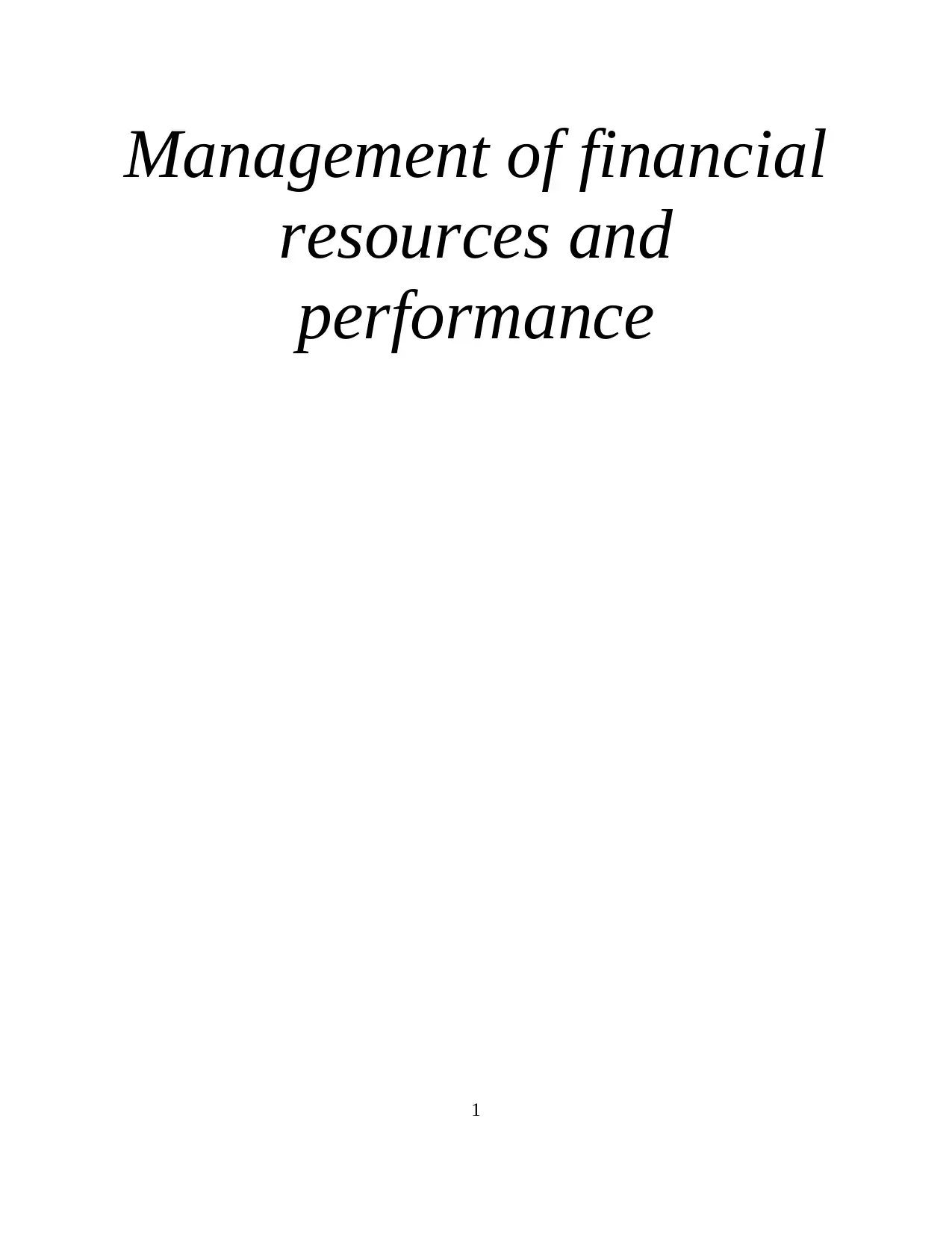
Management of financial
resources and
performance
1
resources and
performance
1
Paraphrase This Document
Need a fresh take? Get an instant paraphrase of this document with our AI Paraphraser
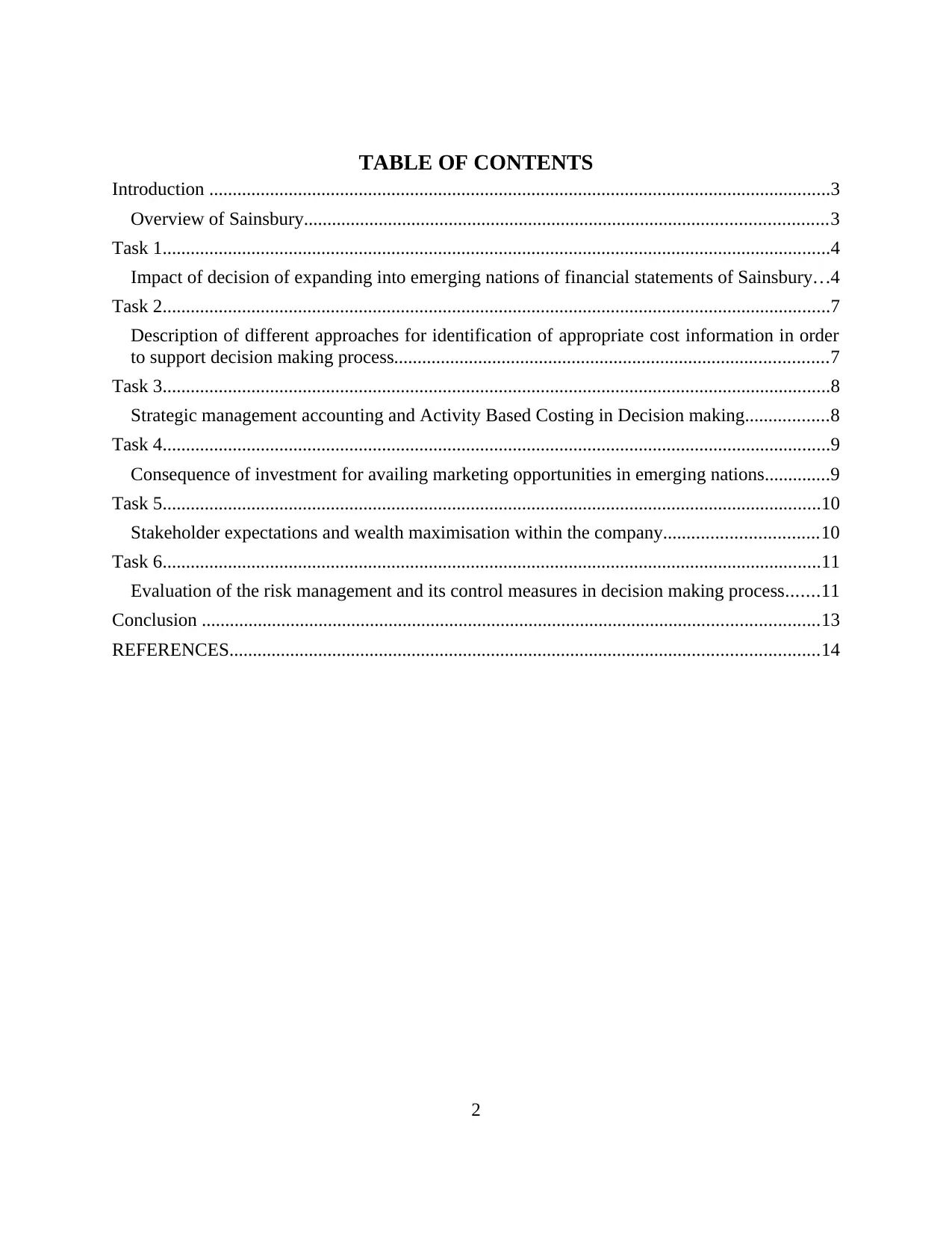
TABLE OF CONTENTS
Introduction .....................................................................................................................................3
Overview of Sainsbury................................................................................................................3
Task 1...............................................................................................................................................4
Impact of decision of expanding into emerging nations of financial statements of Sainsbury...4
Task 2...............................................................................................................................................7
Description of different approaches for identification of appropriate cost information in order
to support decision making process.............................................................................................7
Task 3...............................................................................................................................................8
Strategic management accounting and Activity Based Costing in Decision making..................8
Task 4...............................................................................................................................................9
Consequence of investment for availing marketing opportunities in emerging nations..............9
Task 5.............................................................................................................................................10
Stakeholder expectations and wealth maximisation within the company.................................10
Task 6.............................................................................................................................................11
Evaluation of the risk management and its control measures in decision making process.......11
Conclusion ....................................................................................................................................13
REFERENCES..............................................................................................................................14
2
Introduction .....................................................................................................................................3
Overview of Sainsbury................................................................................................................3
Task 1...............................................................................................................................................4
Impact of decision of expanding into emerging nations of financial statements of Sainsbury...4
Task 2...............................................................................................................................................7
Description of different approaches for identification of appropriate cost information in order
to support decision making process.............................................................................................7
Task 3...............................................................................................................................................8
Strategic management accounting and Activity Based Costing in Decision making..................8
Task 4...............................................................................................................................................9
Consequence of investment for availing marketing opportunities in emerging nations..............9
Task 5.............................................................................................................................................10
Stakeholder expectations and wealth maximisation within the company.................................10
Task 6.............................................................................................................................................11
Evaluation of the risk management and its control measures in decision making process.......11
Conclusion ....................................................................................................................................13
REFERENCES..............................................................................................................................14
2
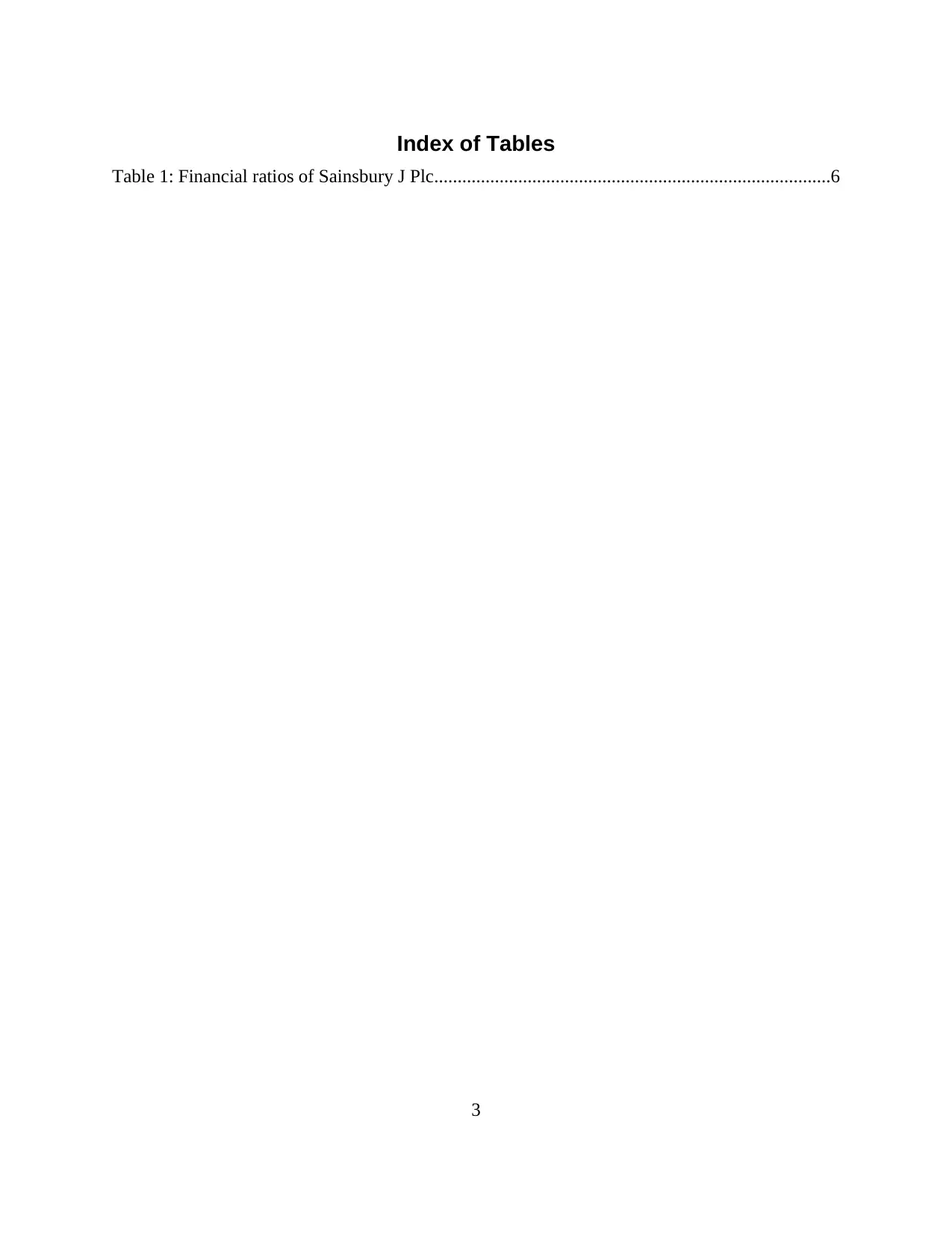
Index of Tables
Table 1: Financial ratios of Sainsbury J Plc.....................................................................................6
3
Table 1: Financial ratios of Sainsbury J Plc.....................................................................................6
3
⊘ This is a preview!⊘
Do you want full access?
Subscribe today to unlock all pages.

Trusted by 1+ million students worldwide
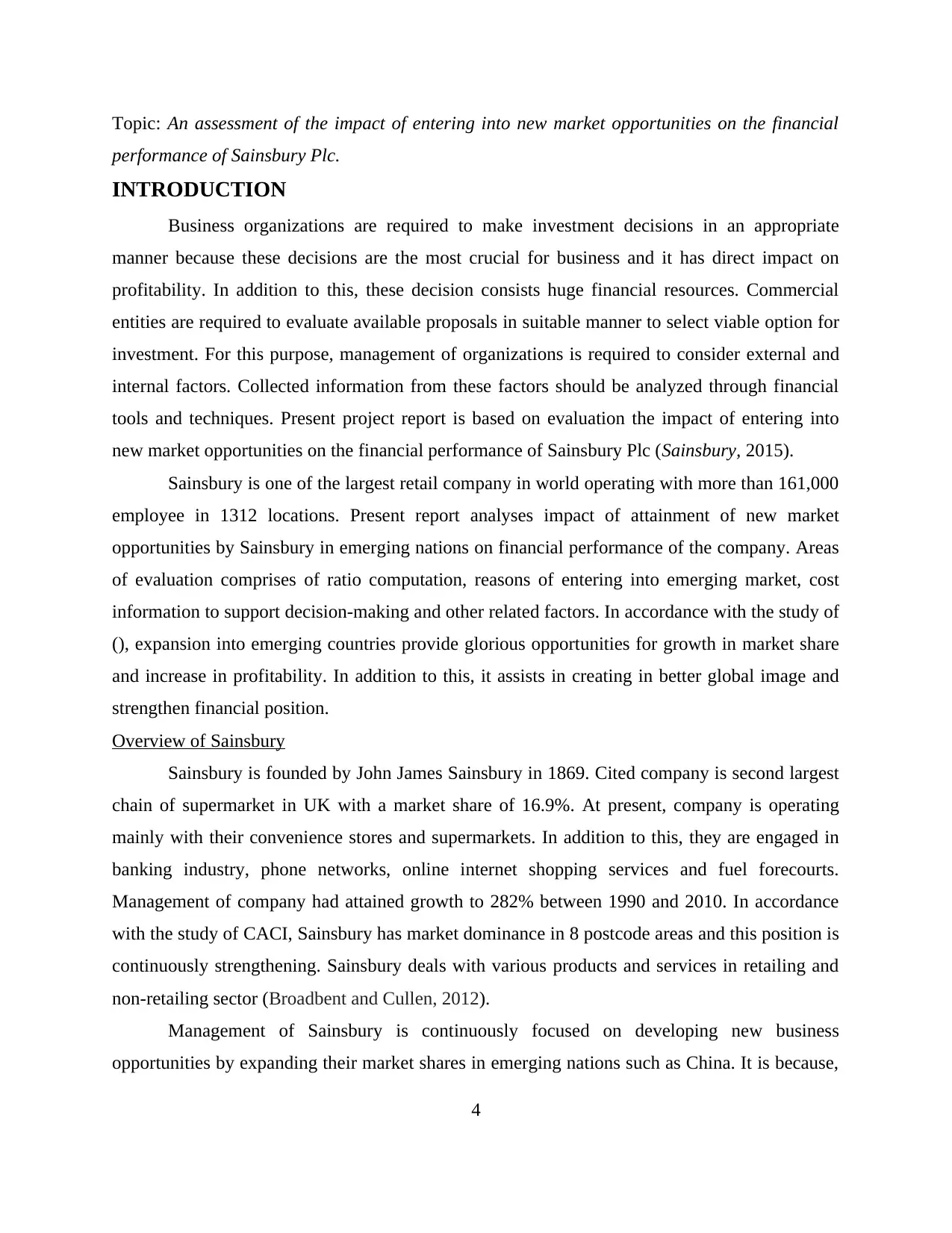
Topic: An assessment of the impact of entering into new market opportunities on the financial
performance of Sainsbury Plc.
INTRODUCTION
Business organizations are required to make investment decisions in an appropriate
manner because these decisions are the most crucial for business and it has direct impact on
profitability. In addition to this, these decision consists huge financial resources. Commercial
entities are required to evaluate available proposals in suitable manner to select viable option for
investment. For this purpose, management of organizations is required to consider external and
internal factors. Collected information from these factors should be analyzed through financial
tools and techniques. Present project report is based on evaluation the impact of entering into
new market opportunities on the financial performance of Sainsbury Plc (Sainsbury, 2015).
Sainsbury is one of the largest retail company in world operating with more than 161,000
employee in 1312 locations. Present report analyses impact of attainment of new market
opportunities by Sainsbury in emerging nations on financial performance of the company. Areas
of evaluation comprises of ratio computation, reasons of entering into emerging market, cost
information to support decision-making and other related factors. In accordance with the study of
(), expansion into emerging countries provide glorious opportunities for growth in market share
and increase in profitability. In addition to this, it assists in creating in better global image and
strengthen financial position.
Overview of Sainsbury
Sainsbury is founded by John James Sainsbury in 1869. Cited company is second largest
chain of supermarket in UK with a market share of 16.9%. At present, company is operating
mainly with their convenience stores and supermarkets. In addition to this, they are engaged in
banking industry, phone networks, online internet shopping services and fuel forecourts.
Management of company had attained growth to 282% between 1990 and 2010. In accordance
with the study of CACI, Sainsbury has market dominance in 8 postcode areas and this position is
continuously strengthening. Sainsbury deals with various products and services in retailing and
non-retailing sector (Broadbent and Cullen, 2012).
Management of Sainsbury is continuously focused on developing new business
opportunities by expanding their market shares in emerging nations such as China. It is because,
4
performance of Sainsbury Plc.
INTRODUCTION
Business organizations are required to make investment decisions in an appropriate
manner because these decisions are the most crucial for business and it has direct impact on
profitability. In addition to this, these decision consists huge financial resources. Commercial
entities are required to evaluate available proposals in suitable manner to select viable option for
investment. For this purpose, management of organizations is required to consider external and
internal factors. Collected information from these factors should be analyzed through financial
tools and techniques. Present project report is based on evaluation the impact of entering into
new market opportunities on the financial performance of Sainsbury Plc (Sainsbury, 2015).
Sainsbury is one of the largest retail company in world operating with more than 161,000
employee in 1312 locations. Present report analyses impact of attainment of new market
opportunities by Sainsbury in emerging nations on financial performance of the company. Areas
of evaluation comprises of ratio computation, reasons of entering into emerging market, cost
information to support decision-making and other related factors. In accordance with the study of
(), expansion into emerging countries provide glorious opportunities for growth in market share
and increase in profitability. In addition to this, it assists in creating in better global image and
strengthen financial position.
Overview of Sainsbury
Sainsbury is founded by John James Sainsbury in 1869. Cited company is second largest
chain of supermarket in UK with a market share of 16.9%. At present, company is operating
mainly with their convenience stores and supermarkets. In addition to this, they are engaged in
banking industry, phone networks, online internet shopping services and fuel forecourts.
Management of company had attained growth to 282% between 1990 and 2010. In accordance
with the study of CACI, Sainsbury has market dominance in 8 postcode areas and this position is
continuously strengthening. Sainsbury deals with various products and services in retailing and
non-retailing sector (Broadbent and Cullen, 2012).
Management of Sainsbury is continuously focused on developing new business
opportunities by expanding their market shares in emerging nations such as China. It is because,
4
Paraphrase This Document
Need a fresh take? Get an instant paraphrase of this document with our AI Paraphraser
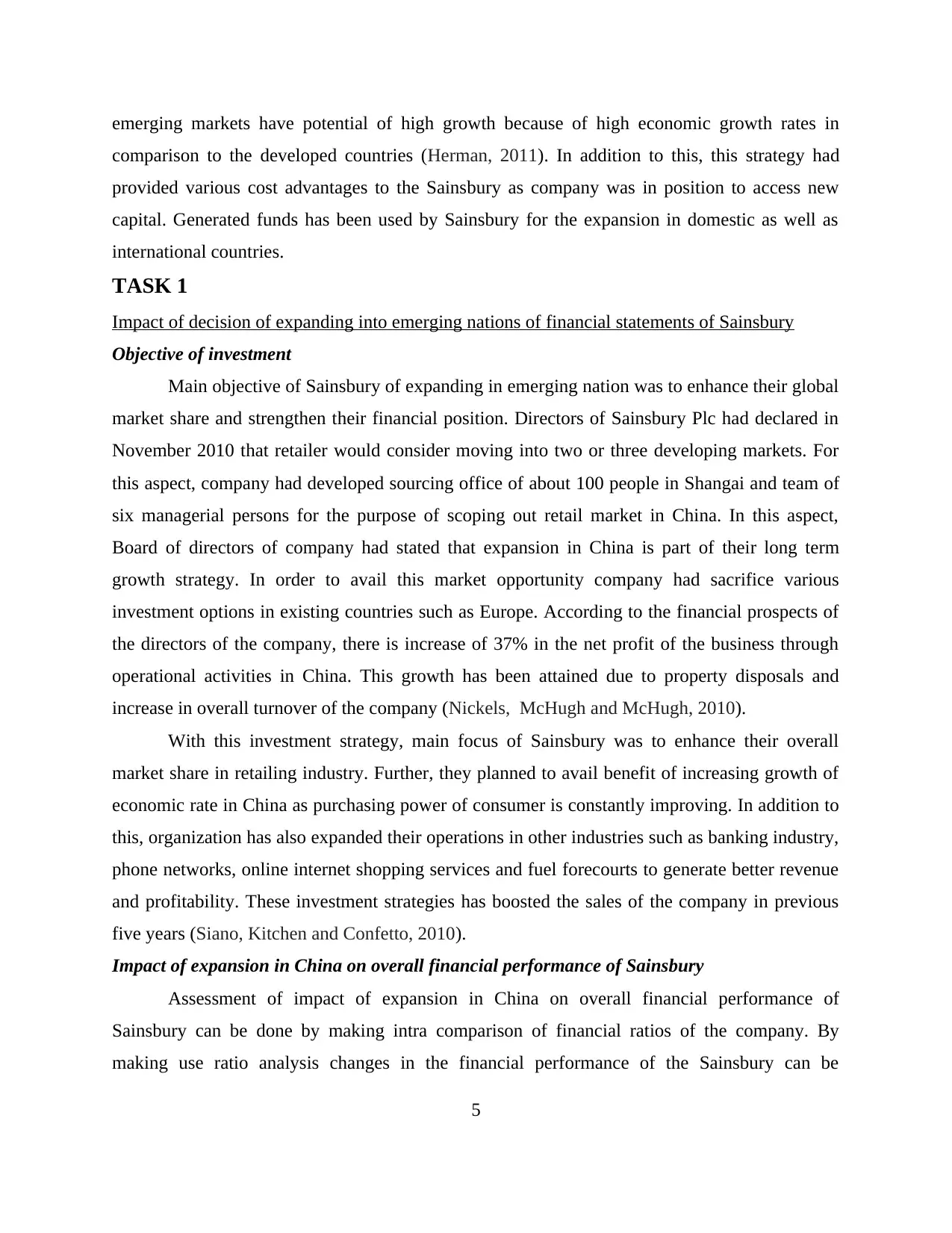
emerging markets have potential of high growth because of high economic growth rates in
comparison to the developed countries (Herman, 2011). In addition to this, this strategy had
provided various cost advantages to the Sainsbury as company was in position to access new
capital. Generated funds has been used by Sainsbury for the expansion in domestic as well as
international countries.
TASK 1
Impact of decision of expanding into emerging nations of financial statements of Sainsbury
Objective of investment
Main objective of Sainsbury of expanding in emerging nation was to enhance their global
market share and strengthen their financial position. Directors of Sainsbury Plc had declared in
November 2010 that retailer would consider moving into two or three developing markets. For
this aspect, company had developed sourcing office of about 100 people in Shangai and team of
six managerial persons for the purpose of scoping out retail market in China. In this aspect,
Board of directors of company had stated that expansion in China is part of their long term
growth strategy. In order to avail this market opportunity company had sacrifice various
investment options in existing countries such as Europe. According to the financial prospects of
the directors of the company, there is increase of 37% in the net profit of the business through
operational activities in China. This growth has been attained due to property disposals and
increase in overall turnover of the company (Nickels, McHugh and McHugh, 2010).
With this investment strategy, main focus of Sainsbury was to enhance their overall
market share in retailing industry. Further, they planned to avail benefit of increasing growth of
economic rate in China as purchasing power of consumer is constantly improving. In addition to
this, organization has also expanded their operations in other industries such as banking industry,
phone networks, online internet shopping services and fuel forecourts to generate better revenue
and profitability. These investment strategies has boosted the sales of the company in previous
five years (Siano, Kitchen and Confetto, 2010).
Impact of expansion in China on overall financial performance of Sainsbury
Assessment of impact of expansion in China on overall financial performance of
Sainsbury can be done by making intra comparison of financial ratios of the company. By
making use ratio analysis changes in the financial performance of the Sainsbury can be
5
comparison to the developed countries (Herman, 2011). In addition to this, this strategy had
provided various cost advantages to the Sainsbury as company was in position to access new
capital. Generated funds has been used by Sainsbury for the expansion in domestic as well as
international countries.
TASK 1
Impact of decision of expanding into emerging nations of financial statements of Sainsbury
Objective of investment
Main objective of Sainsbury of expanding in emerging nation was to enhance their global
market share and strengthen their financial position. Directors of Sainsbury Plc had declared in
November 2010 that retailer would consider moving into two or three developing markets. For
this aspect, company had developed sourcing office of about 100 people in Shangai and team of
six managerial persons for the purpose of scoping out retail market in China. In this aspect,
Board of directors of company had stated that expansion in China is part of their long term
growth strategy. In order to avail this market opportunity company had sacrifice various
investment options in existing countries such as Europe. According to the financial prospects of
the directors of the company, there is increase of 37% in the net profit of the business through
operational activities in China. This growth has been attained due to property disposals and
increase in overall turnover of the company (Nickels, McHugh and McHugh, 2010).
With this investment strategy, main focus of Sainsbury was to enhance their overall
market share in retailing industry. Further, they planned to avail benefit of increasing growth of
economic rate in China as purchasing power of consumer is constantly improving. In addition to
this, organization has also expanded their operations in other industries such as banking industry,
phone networks, online internet shopping services and fuel forecourts to generate better revenue
and profitability. These investment strategies has boosted the sales of the company in previous
five years (Siano, Kitchen and Confetto, 2010).
Impact of expansion in China on overall financial performance of Sainsbury
Assessment of impact of expansion in China on overall financial performance of
Sainsbury can be done by making intra comparison of financial ratios of the company. By
making use ratio analysis changes in the financial performance of the Sainsbury can be
5
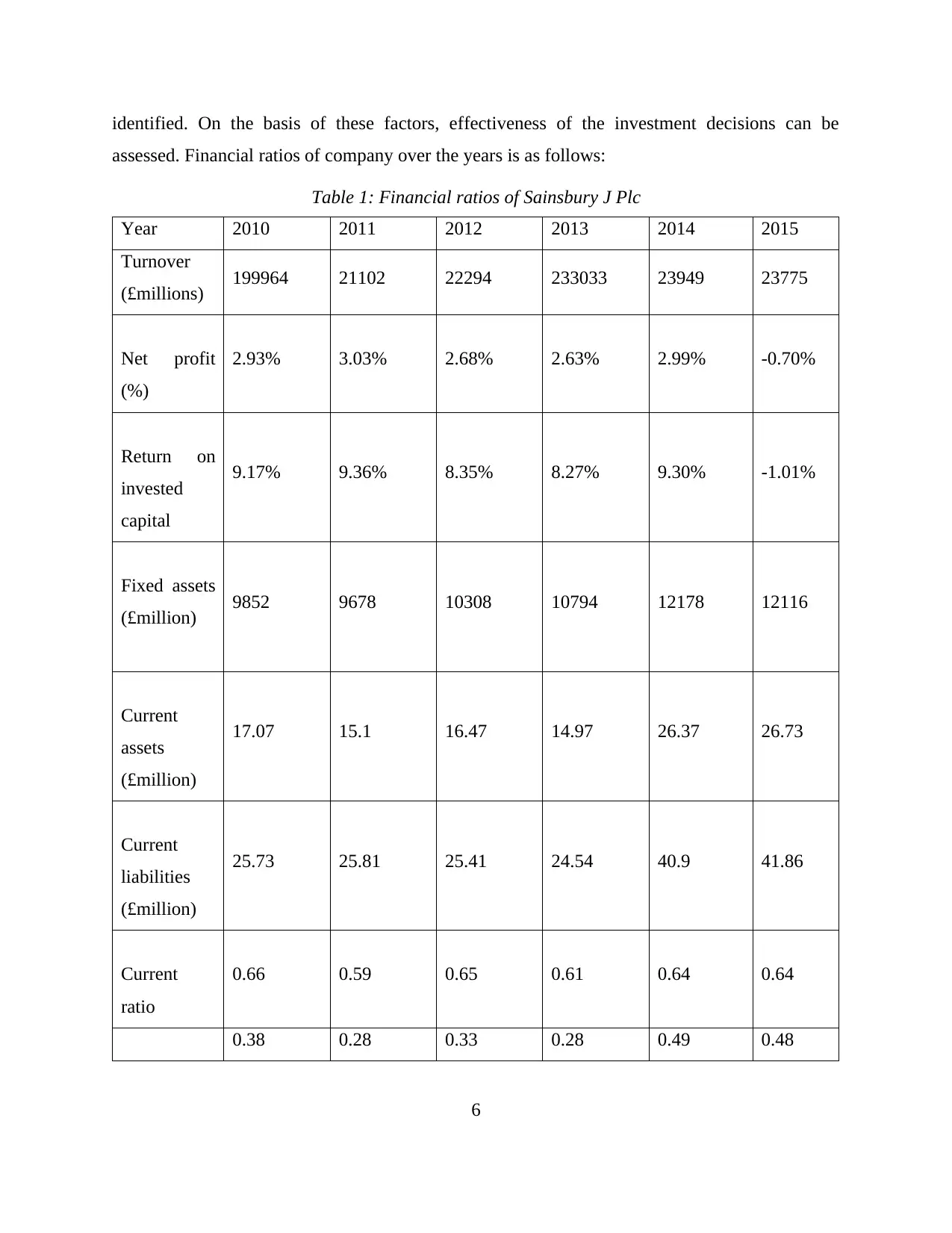
identified. On the basis of these factors, effectiveness of the investment decisions can be
assessed. Financial ratios of company over the years is as follows:
Table 1: Financial ratios of Sainsbury J Plc
Year 2010 2011 2012 2013 2014 2015
Turnover
(£millions) 199964 21102 22294 233033 23949 23775
Net profit
(%)
2.93% 3.03% 2.68% 2.63% 2.99% -0.70%
Return on
invested
capital
9.17% 9.36% 8.35% 8.27% 9.30% -1.01%
Fixed assets
(£million) 9852 9678 10308 10794 12178 12116
Current
assets
(£million)
17.07 15.1 16.47 14.97 26.37 26.73
Current
liabilities
(£million)
25.73 25.81 25.41 24.54 40.9 41.86
Current
ratio
0.66 0.59 0.65 0.61 0.64 0.64
0.38 0.28 0.33 0.28 0.49 0.48
6
assessed. Financial ratios of company over the years is as follows:
Table 1: Financial ratios of Sainsbury J Plc
Year 2010 2011 2012 2013 2014 2015
Turnover
(£millions) 199964 21102 22294 233033 23949 23775
Net profit
(%)
2.93% 3.03% 2.68% 2.63% 2.99% -0.70%
Return on
invested
capital
9.17% 9.36% 8.35% 8.27% 9.30% -1.01%
Fixed assets
(£million) 9852 9678 10308 10794 12178 12116
Current
assets
(£million)
17.07 15.1 16.47 14.97 26.37 26.73
Current
liabilities
(£million)
25.73 25.81 25.41 24.54 40.9 41.86
Current
ratio
0.66 0.59 0.65 0.61 0.64 0.64
0.38 0.28 0.33 0.28 0.49 0.48
6
⊘ This is a preview!⊘
Do you want full access?
Subscribe today to unlock all pages.

Trusted by 1+ million students worldwide
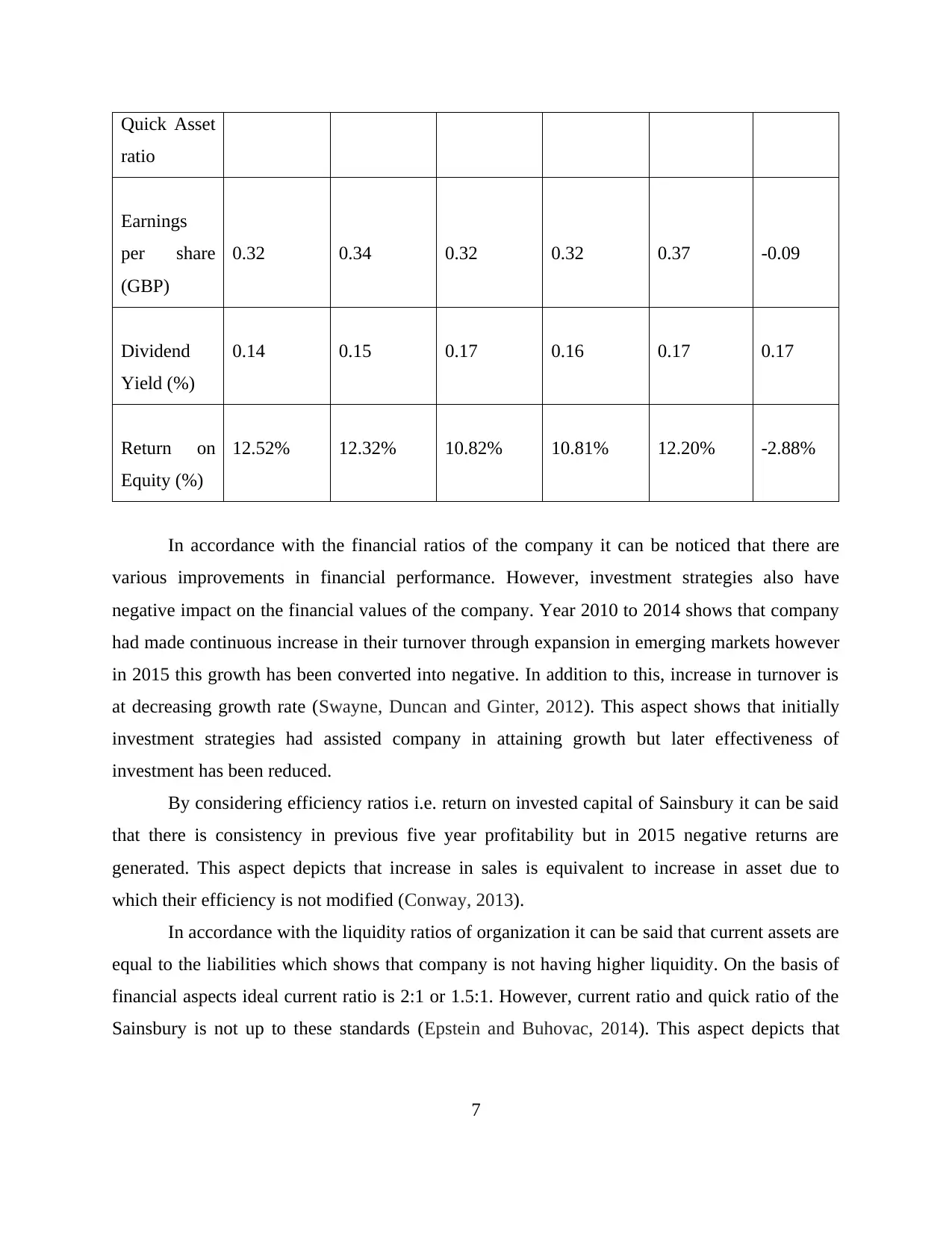
Quick Asset
ratio
Earnings
per share
(GBP)
0.32 0.34 0.32 0.32 0.37 -0.09
Dividend
Yield (%)
0.14 0.15 0.17 0.16 0.17 0.17
Return on
Equity (%)
12.52% 12.32% 10.82% 10.81% 12.20% -2.88%
In accordance with the financial ratios of the company it can be noticed that there are
various improvements in financial performance. However, investment strategies also have
negative impact on the financial values of the company. Year 2010 to 2014 shows that company
had made continuous increase in their turnover through expansion in emerging markets however
in 2015 this growth has been converted into negative. In addition to this, increase in turnover is
at decreasing growth rate (Swayne, Duncan and Ginter, 2012). This aspect shows that initially
investment strategies had assisted company in attaining growth but later effectiveness of
investment has been reduced.
By considering efficiency ratios i.e. return on invested capital of Sainsbury it can be said
that there is consistency in previous five year profitability but in 2015 negative returns are
generated. This aspect depicts that increase in sales is equivalent to increase in asset due to
which their efficiency is not modified (Conway, 2013).
In accordance with the liquidity ratios of organization it can be said that current assets are
equal to the liabilities which shows that company is not having higher liquidity. On the basis of
financial aspects ideal current ratio is 2:1 or 1.5:1. However, current ratio and quick ratio of the
Sainsbury is not up to these standards (Epstein and Buhovac, 2014). This aspect depicts that
7
ratio
Earnings
per share
(GBP)
0.32 0.34 0.32 0.32 0.37 -0.09
Dividend
Yield (%)
0.14 0.15 0.17 0.16 0.17 0.17
Return on
Equity (%)
12.52% 12.32% 10.82% 10.81% 12.20% -2.88%
In accordance with the financial ratios of the company it can be noticed that there are
various improvements in financial performance. However, investment strategies also have
negative impact on the financial values of the company. Year 2010 to 2014 shows that company
had made continuous increase in their turnover through expansion in emerging markets however
in 2015 this growth has been converted into negative. In addition to this, increase in turnover is
at decreasing growth rate (Swayne, Duncan and Ginter, 2012). This aspect shows that initially
investment strategies had assisted company in attaining growth but later effectiveness of
investment has been reduced.
By considering efficiency ratios i.e. return on invested capital of Sainsbury it can be said
that there is consistency in previous five year profitability but in 2015 negative returns are
generated. This aspect depicts that increase in sales is equivalent to increase in asset due to
which their efficiency is not modified (Conway, 2013).
In accordance with the liquidity ratios of organization it can be said that current assets are
equal to the liabilities which shows that company is not having higher liquidity. On the basis of
financial aspects ideal current ratio is 2:1 or 1.5:1. However, current ratio and quick ratio of the
Sainsbury is not up to these standards (Epstein and Buhovac, 2014). This aspect depicts that
7
Paraphrase This Document
Need a fresh take? Get an instant paraphrase of this document with our AI Paraphraser
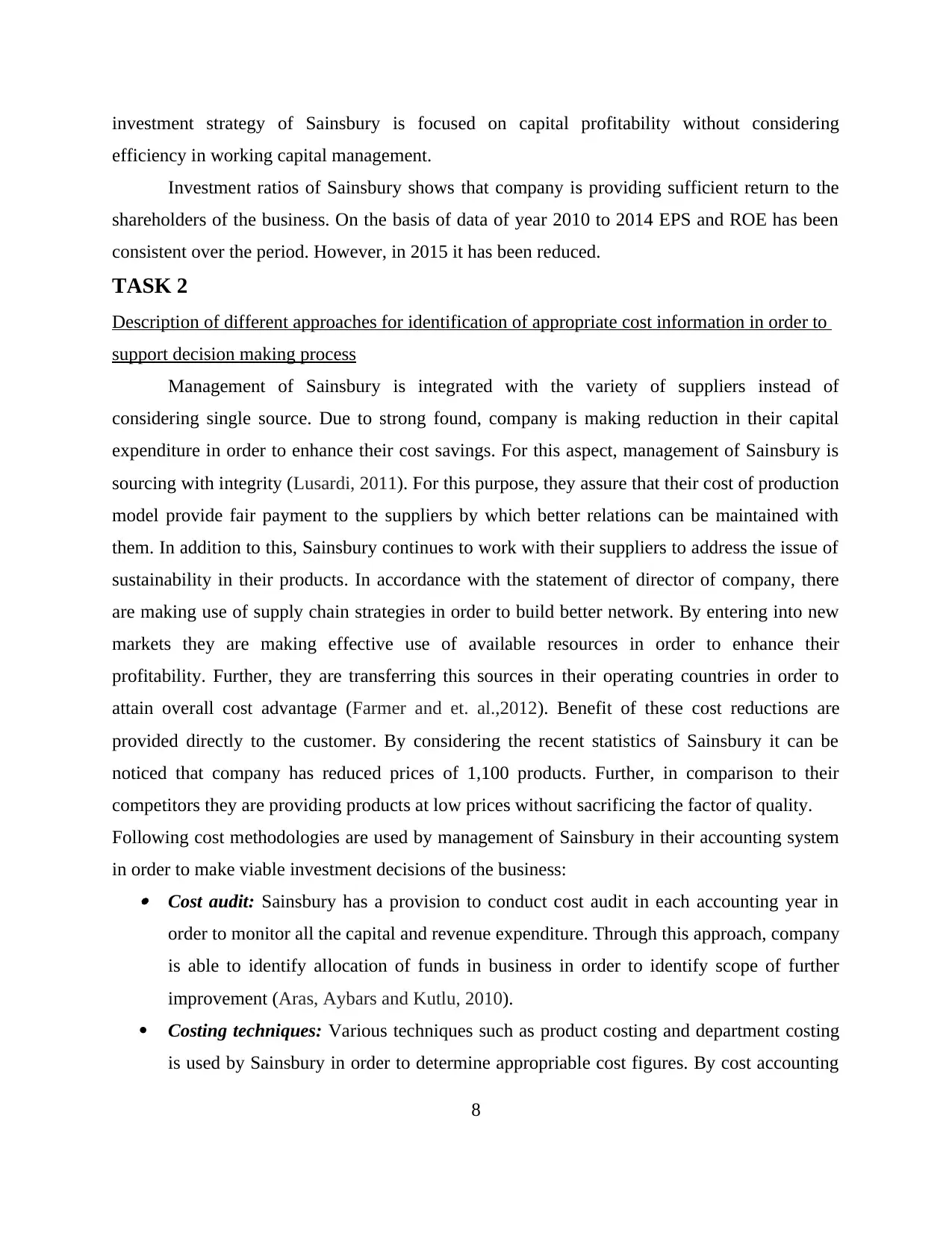
investment strategy of Sainsbury is focused on capital profitability without considering
efficiency in working capital management.
Investment ratios of Sainsbury shows that company is providing sufficient return to the
shareholders of the business. On the basis of data of year 2010 to 2014 EPS and ROE has been
consistent over the period. However, in 2015 it has been reduced.
TASK 2
Description of different approaches for identification of appropriate cost information in order to
support decision making process
Management of Sainsbury is integrated with the variety of suppliers instead of
considering single source. Due to strong found, company is making reduction in their capital
expenditure in order to enhance their cost savings. For this aspect, management of Sainsbury is
sourcing with integrity (Lusardi, 2011). For this purpose, they assure that their cost of production
model provide fair payment to the suppliers by which better relations can be maintained with
them. In addition to this, Sainsbury continues to work with their suppliers to address the issue of
sustainability in their products. In accordance with the statement of director of company, there
are making use of supply chain strategies in order to build better network. By entering into new
markets they are making effective use of available resources in order to enhance their
profitability. Further, they are transferring this sources in their operating countries in order to
attain overall cost advantage (Farmer and et. al.,2012). Benefit of these cost reductions are
provided directly to the customer. By considering the recent statistics of Sainsbury it can be
noticed that company has reduced prices of 1,100 products. Further, in comparison to their
competitors they are providing products at low prices without sacrificing the factor of quality.
Following cost methodologies are used by management of Sainsbury in their accounting system
in order to make viable investment decisions of the business: Cost audit: Sainsbury has a provision to conduct cost audit in each accounting year in
order to monitor all the capital and revenue expenditure. Through this approach, company
is able to identify allocation of funds in business in order to identify scope of further
improvement (Aras, Aybars and Kutlu, 2010).
Costing techniques: Various techniques such as product costing and department costing
is used by Sainsbury in order to determine appropriable cost figures. By cost accounting
8
efficiency in working capital management.
Investment ratios of Sainsbury shows that company is providing sufficient return to the
shareholders of the business. On the basis of data of year 2010 to 2014 EPS and ROE has been
consistent over the period. However, in 2015 it has been reduced.
TASK 2
Description of different approaches for identification of appropriate cost information in order to
support decision making process
Management of Sainsbury is integrated with the variety of suppliers instead of
considering single source. Due to strong found, company is making reduction in their capital
expenditure in order to enhance their cost savings. For this aspect, management of Sainsbury is
sourcing with integrity (Lusardi, 2011). For this purpose, they assure that their cost of production
model provide fair payment to the suppliers by which better relations can be maintained with
them. In addition to this, Sainsbury continues to work with their suppliers to address the issue of
sustainability in their products. In accordance with the statement of director of company, there
are making use of supply chain strategies in order to build better network. By entering into new
markets they are making effective use of available resources in order to enhance their
profitability. Further, they are transferring this sources in their operating countries in order to
attain overall cost advantage (Farmer and et. al.,2012). Benefit of these cost reductions are
provided directly to the customer. By considering the recent statistics of Sainsbury it can be
noticed that company has reduced prices of 1,100 products. Further, in comparison to their
competitors they are providing products at low prices without sacrificing the factor of quality.
Following cost methodologies are used by management of Sainsbury in their accounting system
in order to make viable investment decisions of the business: Cost audit: Sainsbury has a provision to conduct cost audit in each accounting year in
order to monitor all the capital and revenue expenditure. Through this approach, company
is able to identify allocation of funds in business in order to identify scope of further
improvement (Aras, Aybars and Kutlu, 2010).
Costing techniques: Various techniques such as product costing and department costing
is used by Sainsbury in order to determine appropriable cost figures. By cost accounting
8
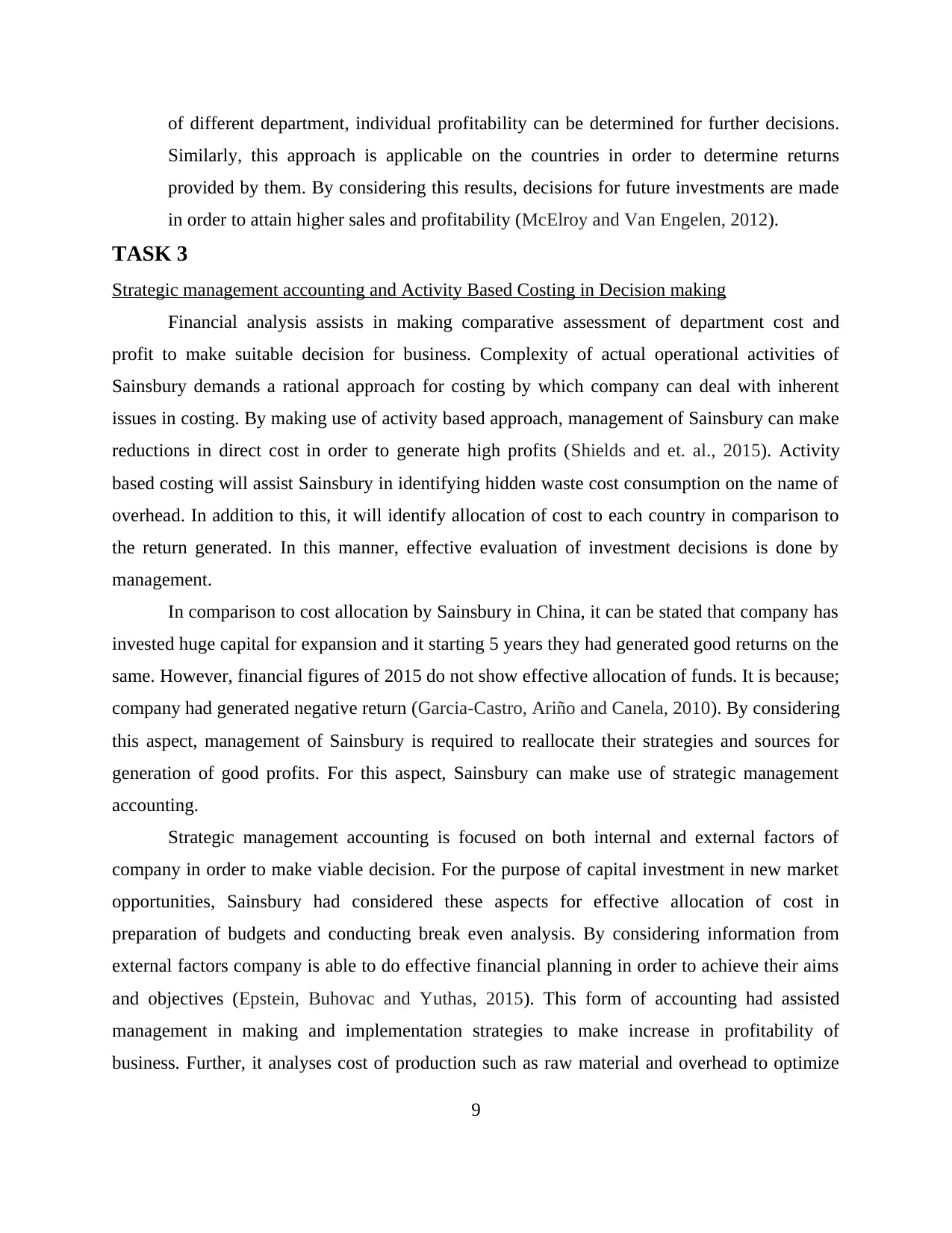
of different department, individual profitability can be determined for further decisions.
Similarly, this approach is applicable on the countries in order to determine returns
provided by them. By considering this results, decisions for future investments are made
in order to attain higher sales and profitability (McElroy and Van Engelen, 2012).
TASK 3
Strategic management accounting and Activity Based Costing in Decision making
Financial analysis assists in making comparative assessment of department cost and
profit to make suitable decision for business. Complexity of actual operational activities of
Sainsbury demands a rational approach for costing by which company can deal with inherent
issues in costing. By making use of activity based approach, management of Sainsbury can make
reductions in direct cost in order to generate high profits (Shields and et. al., 2015). Activity
based costing will assist Sainsbury in identifying hidden waste cost consumption on the name of
overhead. In addition to this, it will identify allocation of cost to each country in comparison to
the return generated. In this manner, effective evaluation of investment decisions is done by
management.
In comparison to cost allocation by Sainsbury in China, it can be stated that company has
invested huge capital for expansion and it starting 5 years they had generated good returns on the
same. However, financial figures of 2015 do not show effective allocation of funds. It is because;
company had generated negative return (Garcia-Castro, Ariño and Canela, 2010). By considering
this aspect, management of Sainsbury is required to reallocate their strategies and sources for
generation of good profits. For this aspect, Sainsbury can make use of strategic management
accounting.
Strategic management accounting is focused on both internal and external factors of
company in order to make viable decision. For the purpose of capital investment in new market
opportunities, Sainsbury had considered these aspects for effective allocation of cost in
preparation of budgets and conducting break even analysis. By considering information from
external factors company is able to do effective financial planning in order to achieve their aims
and objectives (Epstein, Buhovac and Yuthas, 2015). This form of accounting had assisted
management in making and implementation strategies to make increase in profitability of
business. Further, it analyses cost of production such as raw material and overhead to optimize
9
Similarly, this approach is applicable on the countries in order to determine returns
provided by them. By considering this results, decisions for future investments are made
in order to attain higher sales and profitability (McElroy and Van Engelen, 2012).
TASK 3
Strategic management accounting and Activity Based Costing in Decision making
Financial analysis assists in making comparative assessment of department cost and
profit to make suitable decision for business. Complexity of actual operational activities of
Sainsbury demands a rational approach for costing by which company can deal with inherent
issues in costing. By making use of activity based approach, management of Sainsbury can make
reductions in direct cost in order to generate high profits (Shields and et. al., 2015). Activity
based costing will assist Sainsbury in identifying hidden waste cost consumption on the name of
overhead. In addition to this, it will identify allocation of cost to each country in comparison to
the return generated. In this manner, effective evaluation of investment decisions is done by
management.
In comparison to cost allocation by Sainsbury in China, it can be stated that company has
invested huge capital for expansion and it starting 5 years they had generated good returns on the
same. However, financial figures of 2015 do not show effective allocation of funds. It is because;
company had generated negative return (Garcia-Castro, Ariño and Canela, 2010). By considering
this aspect, management of Sainsbury is required to reallocate their strategies and sources for
generation of good profits. For this aspect, Sainsbury can make use of strategic management
accounting.
Strategic management accounting is focused on both internal and external factors of
company in order to make viable decision. For the purpose of capital investment in new market
opportunities, Sainsbury had considered these aspects for effective allocation of cost in
preparation of budgets and conducting break even analysis. By considering information from
external factors company is able to do effective financial planning in order to achieve their aims
and objectives (Epstein, Buhovac and Yuthas, 2015). This form of accounting had assisted
management in making and implementation strategies to make increase in profitability of
business. Further, it analyses cost of production such as raw material and overhead to optimize
9
⊘ This is a preview!⊘
Do you want full access?
Subscribe today to unlock all pages.

Trusted by 1+ million students worldwide
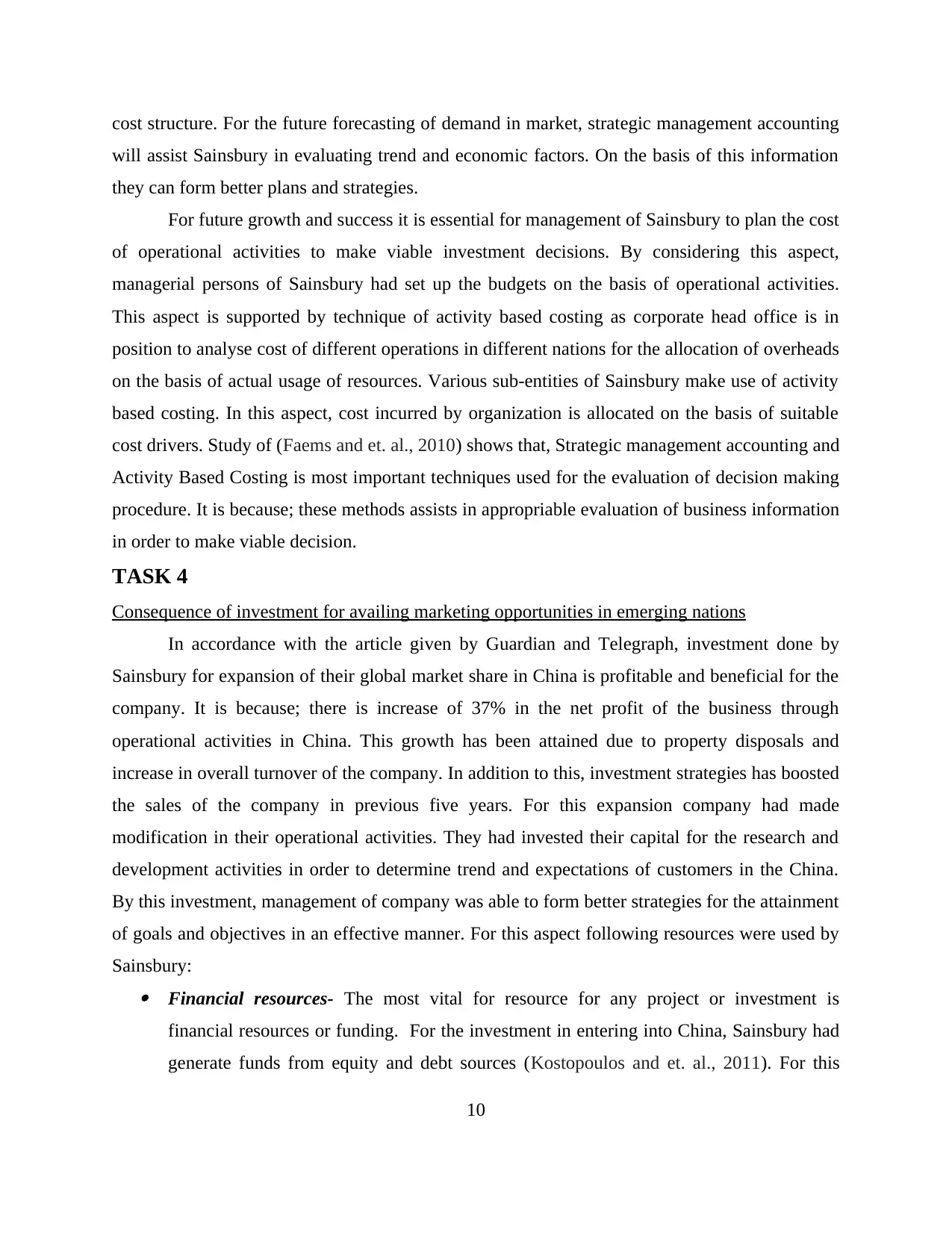
cost structure. For the future forecasting of demand in market, strategic management accounting
will assist Sainsbury in evaluating trend and economic factors. On the basis of this information
they can form better plans and strategies.
For future growth and success it is essential for management of Sainsbury to plan the cost
of operational activities to make viable investment decisions. By considering this aspect,
managerial persons of Sainsbury had set up the budgets on the basis of operational activities.
This aspect is supported by technique of activity based costing as corporate head office is in
position to analyse cost of different operations in different nations for the allocation of overheads
on the basis of actual usage of resources. Various sub-entities of Sainsbury make use of activity
based costing. In this aspect, cost incurred by organization is allocated on the basis of suitable
cost drivers. Study of (Faems and et. al., 2010) shows that, Strategic management accounting and
Activity Based Costing is most important techniques used for the evaluation of decision making
procedure. It is because; these methods assists in appropriable evaluation of business information
in order to make viable decision.
TASK 4
Consequence of investment for availing marketing opportunities in emerging nations
In accordance with the article given by Guardian and Telegraph, investment done by
Sainsbury for expansion of their global market share in China is profitable and beneficial for the
company. It is because; there is increase of 37% in the net profit of the business through
operational activities in China. This growth has been attained due to property disposals and
increase in overall turnover of the company. In addition to this, investment strategies has boosted
the sales of the company in previous five years. For this expansion company had made
modification in their operational activities. They had invested their capital for the research and
development activities in order to determine trend and expectations of customers in the China.
By this investment, management of company was able to form better strategies for the attainment
of goals and objectives in an effective manner. For this aspect following resources were used by
Sainsbury: Financial resources- The most vital for resource for any project or investment is
financial resources or funding. For the investment in entering into China, Sainsbury had
generate funds from equity and debt sources (Kostopoulos and et. al., 2011). For this
10
will assist Sainsbury in evaluating trend and economic factors. On the basis of this information
they can form better plans and strategies.
For future growth and success it is essential for management of Sainsbury to plan the cost
of operational activities to make viable investment decisions. By considering this aspect,
managerial persons of Sainsbury had set up the budgets on the basis of operational activities.
This aspect is supported by technique of activity based costing as corporate head office is in
position to analyse cost of different operations in different nations for the allocation of overheads
on the basis of actual usage of resources. Various sub-entities of Sainsbury make use of activity
based costing. In this aspect, cost incurred by organization is allocated on the basis of suitable
cost drivers. Study of (Faems and et. al., 2010) shows that, Strategic management accounting and
Activity Based Costing is most important techniques used for the evaluation of decision making
procedure. It is because; these methods assists in appropriable evaluation of business information
in order to make viable decision.
TASK 4
Consequence of investment for availing marketing opportunities in emerging nations
In accordance with the article given by Guardian and Telegraph, investment done by
Sainsbury for expansion of their global market share in China is profitable and beneficial for the
company. It is because; there is increase of 37% in the net profit of the business through
operational activities in China. This growth has been attained due to property disposals and
increase in overall turnover of the company. In addition to this, investment strategies has boosted
the sales of the company in previous five years. For this expansion company had made
modification in their operational activities. They had invested their capital for the research and
development activities in order to determine trend and expectations of customers in the China.
By this investment, management of company was able to form better strategies for the attainment
of goals and objectives in an effective manner. For this aspect following resources were used by
Sainsbury: Financial resources- The most vital for resource for any project or investment is
financial resources or funding. For the investment in entering into China, Sainsbury had
generate funds from equity and debt sources (Kostopoulos and et. al., 2011). For this
10
Paraphrase This Document
Need a fresh take? Get an instant paraphrase of this document with our AI Paraphraser
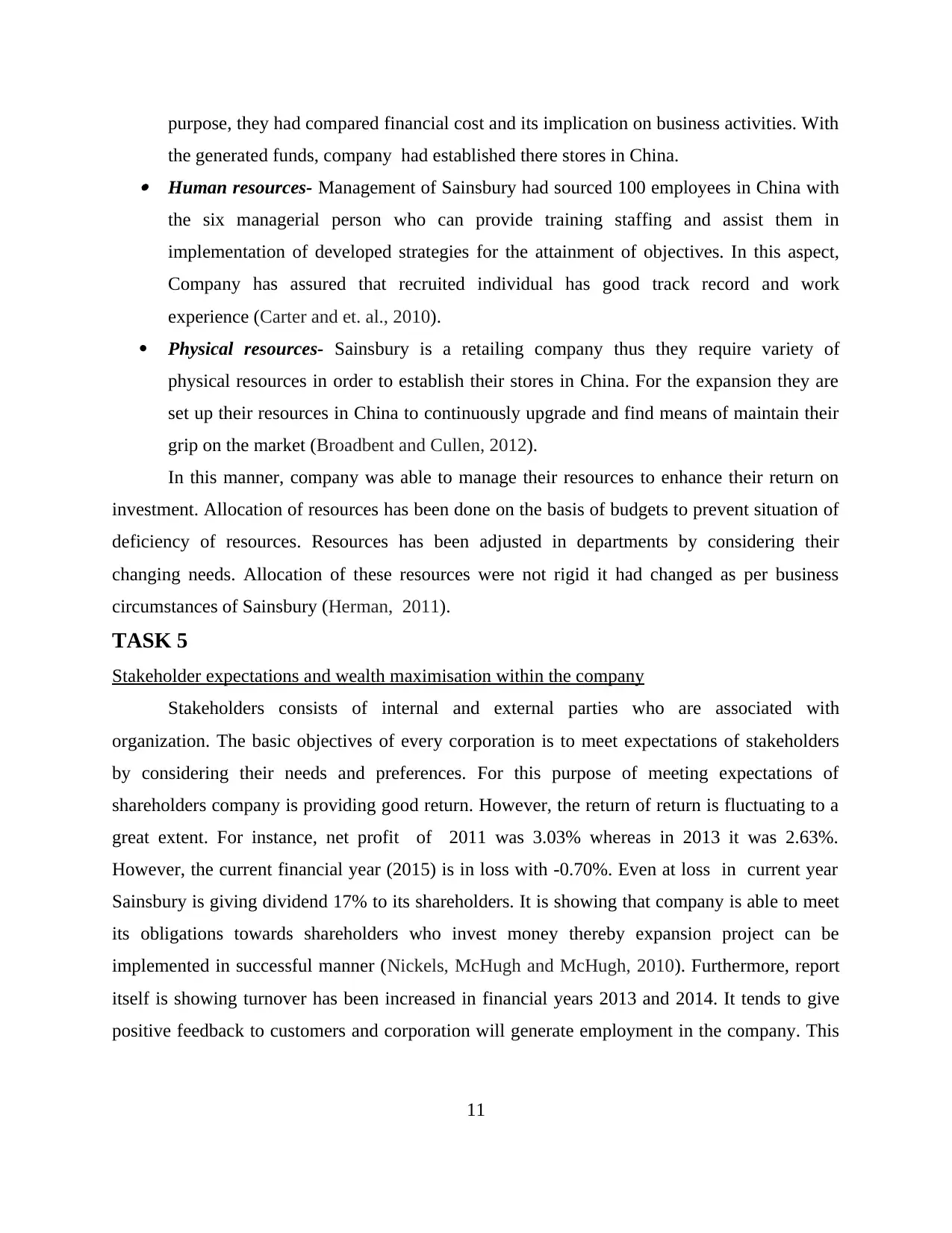
purpose, they had compared financial cost and its implication on business activities. With
the generated funds, company had established there stores in China. Human resources- Management of Sainsbury had sourced 100 employees in China with
the six managerial person who can provide training staffing and assist them in
implementation of developed strategies for the attainment of objectives. In this aspect,
Company has assured that recruited individual has good track record and work
experience (Carter and et. al., 2010).
Physical resources- Sainsbury is a retailing company thus they require variety of
physical resources in order to establish their stores in China. For the expansion they are
set up their resources in China to continuously upgrade and find means of maintain their
grip on the market (Broadbent and Cullen, 2012).
In this manner, company was able to manage their resources to enhance their return on
investment. Allocation of resources has been done on the basis of budgets to prevent situation of
deficiency of resources. Resources has been adjusted in departments by considering their
changing needs. Allocation of these resources were not rigid it had changed as per business
circumstances of Sainsbury (Herman, 2011).
TASK 5
Stakeholder expectations and wealth maximisation within the company
Stakeholders consists of internal and external parties who are associated with
organization. The basic objectives of every corporation is to meet expectations of stakeholders
by considering their needs and preferences. For this purpose of meeting expectations of
shareholders company is providing good return. However, the return of return is fluctuating to a
great extent. For instance, net profit of 2011 was 3.03% whereas in 2013 it was 2.63%.
However, the current financial year (2015) is in loss with -0.70%. Even at loss in current year
Sainsbury is giving dividend 17% to its shareholders. It is showing that company is able to meet
its obligations towards shareholders who invest money thereby expansion project can be
implemented in successful manner (Nickels, McHugh and McHugh, 2010). Furthermore, report
itself is showing turnover has been increased in financial years 2013 and 2014. It tends to give
positive feedback to customers and corporation will generate employment in the company. This
11
the generated funds, company had established there stores in China. Human resources- Management of Sainsbury had sourced 100 employees in China with
the six managerial person who can provide training staffing and assist them in
implementation of developed strategies for the attainment of objectives. In this aspect,
Company has assured that recruited individual has good track record and work
experience (Carter and et. al., 2010).
Physical resources- Sainsbury is a retailing company thus they require variety of
physical resources in order to establish their stores in China. For the expansion they are
set up their resources in China to continuously upgrade and find means of maintain their
grip on the market (Broadbent and Cullen, 2012).
In this manner, company was able to manage their resources to enhance their return on
investment. Allocation of resources has been done on the basis of budgets to prevent situation of
deficiency of resources. Resources has been adjusted in departments by considering their
changing needs. Allocation of these resources were not rigid it had changed as per business
circumstances of Sainsbury (Herman, 2011).
TASK 5
Stakeholder expectations and wealth maximisation within the company
Stakeholders consists of internal and external parties who are associated with
organization. The basic objectives of every corporation is to meet expectations of stakeholders
by considering their needs and preferences. For this purpose of meeting expectations of
shareholders company is providing good return. However, the return of return is fluctuating to a
great extent. For instance, net profit of 2011 was 3.03% whereas in 2013 it was 2.63%.
However, the current financial year (2015) is in loss with -0.70%. Even at loss in current year
Sainsbury is giving dividend 17% to its shareholders. It is showing that company is able to meet
its obligations towards shareholders who invest money thereby expansion project can be
implemented in successful manner (Nickels, McHugh and McHugh, 2010). Furthermore, report
itself is showing turnover has been increased in financial years 2013 and 2014. It tends to give
positive feedback to customers and corporation will generate employment in the company. This
11
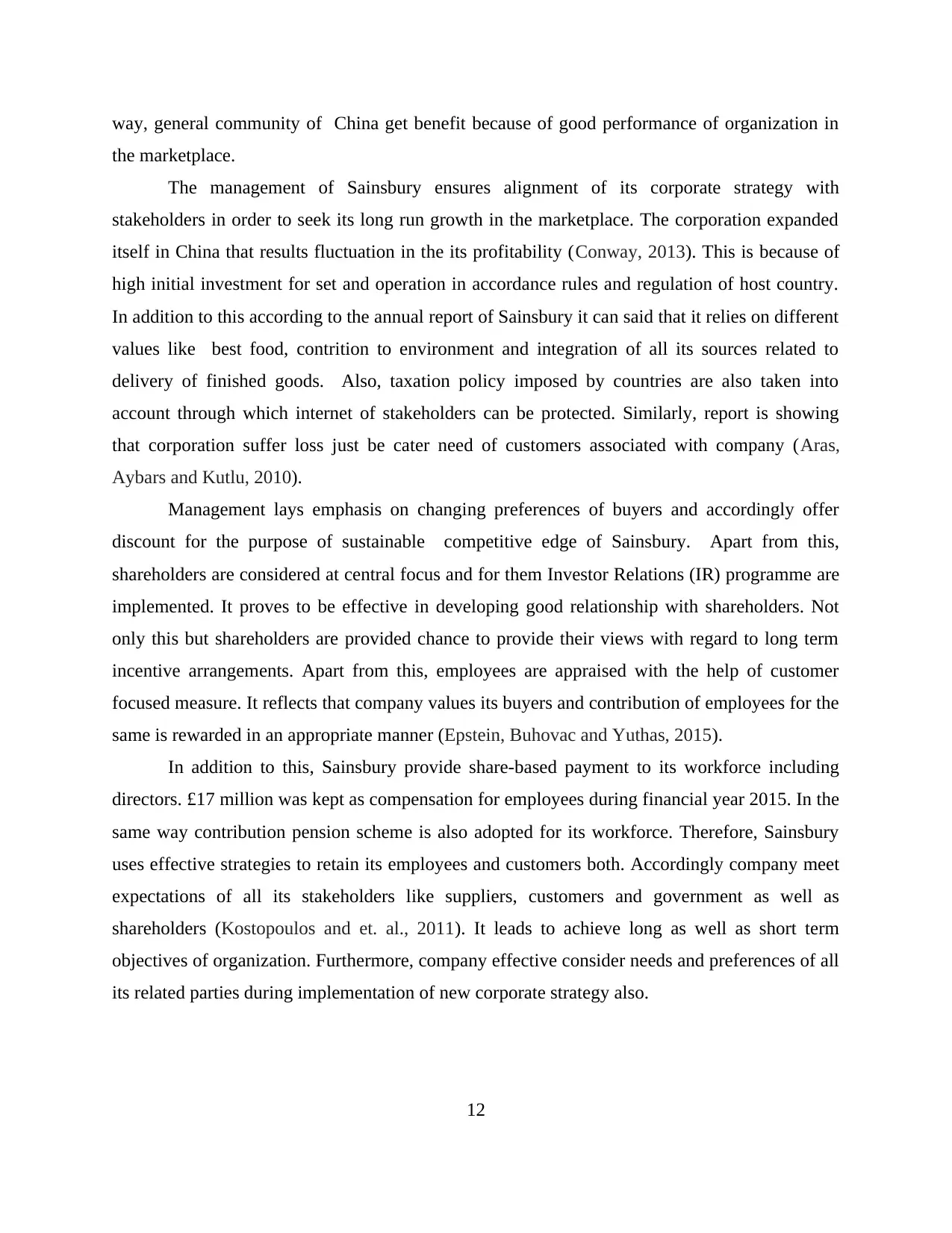
way, general community of China get benefit because of good performance of organization in
the marketplace.
The management of Sainsbury ensures alignment of its corporate strategy with
stakeholders in order to seek its long run growth in the marketplace. The corporation expanded
itself in China that results fluctuation in the its profitability (Conway, 2013). This is because of
high initial investment for set and operation in accordance rules and regulation of host country.
In addition to this according to the annual report of Sainsbury it can said that it relies on different
values like best food, contrition to environment and integration of all its sources related to
delivery of finished goods. Also, taxation policy imposed by countries are also taken into
account through which internet of stakeholders can be protected. Similarly, report is showing
that corporation suffer loss just be cater need of customers associated with company (Aras,
Aybars and Kutlu, 2010).
Management lays emphasis on changing preferences of buyers and accordingly offer
discount for the purpose of sustainable competitive edge of Sainsbury. Apart from this,
shareholders are considered at central focus and for them Investor Relations (IR) programme are
implemented. It proves to be effective in developing good relationship with shareholders. Not
only this but shareholders are provided chance to provide their views with regard to long term
incentive arrangements. Apart from this, employees are appraised with the help of customer
focused measure. It reflects that company values its buyers and contribution of employees for the
same is rewarded in an appropriate manner (Epstein, Buhovac and Yuthas, 2015).
In addition to this, Sainsbury provide share-based payment to its workforce including
directors. £17 million was kept as compensation for employees during financial year 2015. In the
same way contribution pension scheme is also adopted for its workforce. Therefore, Sainsbury
uses effective strategies to retain its employees and customers both. Accordingly company meet
expectations of all its stakeholders like suppliers, customers and government as well as
shareholders (Kostopoulos and et. al., 2011). It leads to achieve long as well as short term
objectives of organization. Furthermore, company effective consider needs and preferences of all
its related parties during implementation of new corporate strategy also.
12
the marketplace.
The management of Sainsbury ensures alignment of its corporate strategy with
stakeholders in order to seek its long run growth in the marketplace. The corporation expanded
itself in China that results fluctuation in the its profitability (Conway, 2013). This is because of
high initial investment for set and operation in accordance rules and regulation of host country.
In addition to this according to the annual report of Sainsbury it can said that it relies on different
values like best food, contrition to environment and integration of all its sources related to
delivery of finished goods. Also, taxation policy imposed by countries are also taken into
account through which internet of stakeholders can be protected. Similarly, report is showing
that corporation suffer loss just be cater need of customers associated with company (Aras,
Aybars and Kutlu, 2010).
Management lays emphasis on changing preferences of buyers and accordingly offer
discount for the purpose of sustainable competitive edge of Sainsbury. Apart from this,
shareholders are considered at central focus and for them Investor Relations (IR) programme are
implemented. It proves to be effective in developing good relationship with shareholders. Not
only this but shareholders are provided chance to provide their views with regard to long term
incentive arrangements. Apart from this, employees are appraised with the help of customer
focused measure. It reflects that company values its buyers and contribution of employees for the
same is rewarded in an appropriate manner (Epstein, Buhovac and Yuthas, 2015).
In addition to this, Sainsbury provide share-based payment to its workforce including
directors. £17 million was kept as compensation for employees during financial year 2015. In the
same way contribution pension scheme is also adopted for its workforce. Therefore, Sainsbury
uses effective strategies to retain its employees and customers both. Accordingly company meet
expectations of all its stakeholders like suppliers, customers and government as well as
shareholders (Kostopoulos and et. al., 2011). It leads to achieve long as well as short term
objectives of organization. Furthermore, company effective consider needs and preferences of all
its related parties during implementation of new corporate strategy also.
12
⊘ This is a preview!⊘
Do you want full access?
Subscribe today to unlock all pages.

Trusted by 1+ million students worldwide
1 out of 16
Related Documents
Your All-in-One AI-Powered Toolkit for Academic Success.
+13062052269
info@desklib.com
Available 24*7 on WhatsApp / Email
![[object Object]](/_next/static/media/star-bottom.7253800d.svg)
Unlock your academic potential
Copyright © 2020–2025 A2Z Services. All Rights Reserved. Developed and managed by ZUCOL.





